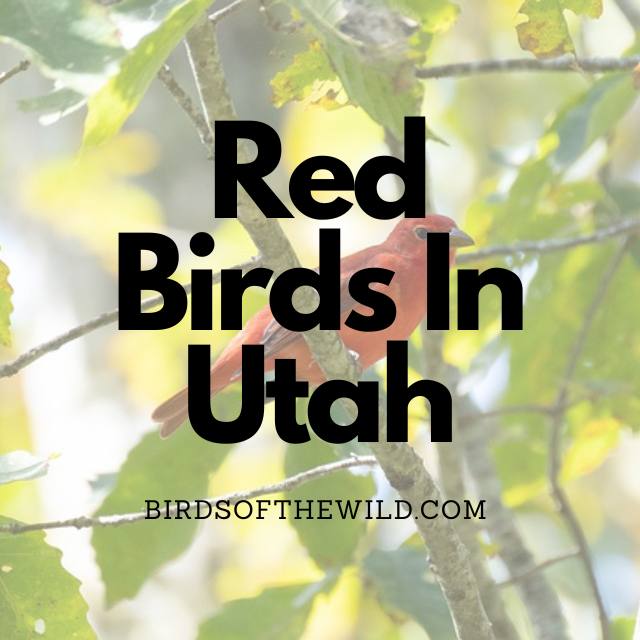In this article I’ll be going over 9 red birds that can be found throughout Utah so, continue reading for a more a detailed look at each of these birds below.
- Pine Grosbeak
- House Finch
- White Winged Crossbill
- Red Naped Sapsucker
- Common Redpoll
- Western Tanager
- Summer Tanager
- Northern Flicker
- Red Winged Blackbird
9 Red Birds In Utah
1. Pine Grosbeak (Pinicola Enucleator)
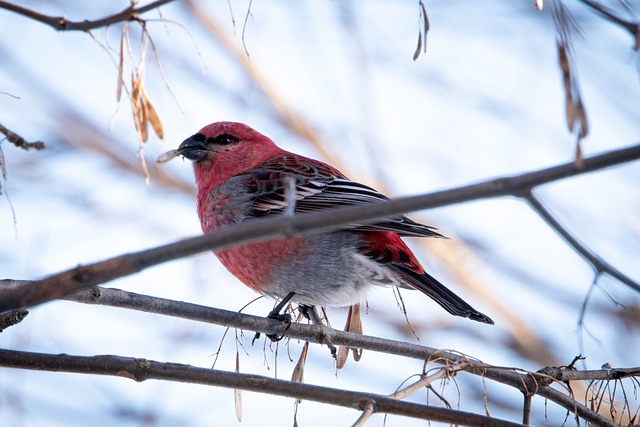
- Size: 20 – 25.5cm
- Weight: 52 – 58 grams
- Wingspan: 31 – 35cm
You’ll find pine grosbeaks in northeast Utah on a year round basis.
Pine grosbeaks are recognised by their greyish white wings and tail feathers, a redish pink body and head along with a black beak and feet. Female grosbeaks are not nearly as vibrant as the males with their plumage a generally light gray color with hints of orange around the torso and tail.
Pine grosbeaks spend the majority of their time within coniferous woods where the may straddle on a horizontal branch when resting and hunt for small insects, seeds, buds, berries among other refreshing fruits when on the move.
These birds are known to live up till 9 years old, sometimes even more so they have a moderately long lifespans for birds of their size.
2. House Finch (Haemorhous Mexicanus)
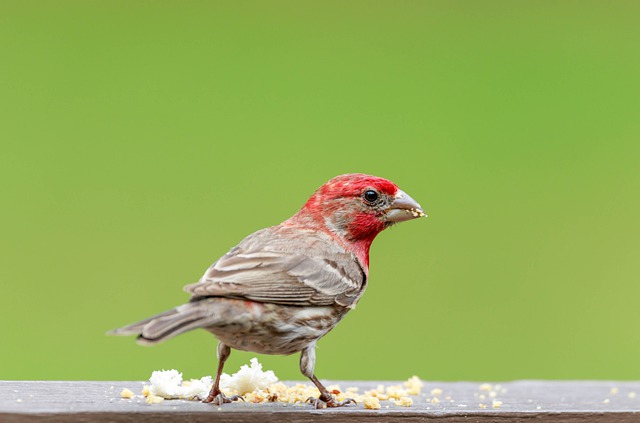
- Size: 12.5 – 15cm
- Weight: 19 – 22 grams
- Wingspan: 20 – 25cm
House finches are year round residents across all of Utah.
A House finch can be recognised by its red and brown plumage with their body mostly light brown and the head made up of a gradient red color with hints of brown. Females on the other hand are mostly brown with hints of black on their wings and back.
As for where you can find house finches, the number of habitats they stay within are quite vast ranging from dry desert, desert grassland, chaparral, oak savannah, streamsides, and open coniferous forests at elevations below 6,000 feet.
If the food is to their liking, like black sunflower seeds, these little birds will on occasion make their way to a feeder set out by a citizen. Other than seeds house finches also eat small insects like aphids as well as fruits and berries.
In the wild, house finches are known to live for around 10 years whilst captive finches can live upwards of 12 years.
3. White Winged Crossbill (Loxia Leucoptera)

- Size: 15 – 17cm
- Weight: 24 – 30 grams
- Wingspan: 26 – 28cm
White winged crossbills can be found in the majority of Utah throughout their non-breeding months.
These white winged crossbill (also called two barred crossbills) are recognised by their red plumage across the head and body, black wings with white stripes and their downward pointing bill that crosses over itself. On the other hand females are mostly gray and green in color.
These crossbills can be found living in montane coniferous forests among boreal trees with mature spruce and larch. As for what the two barred crossbill eat, it includes pine cones, grass, docks, thrift seeds as well as smaller insects like caterpillars, aphids, spiders etc.
White winged crossbills are also known to live for around 4 years in the wild although the numbers may differ for captive ones.
4. Red Naped Sapsucker (Sphyrapicus Nuchalis)
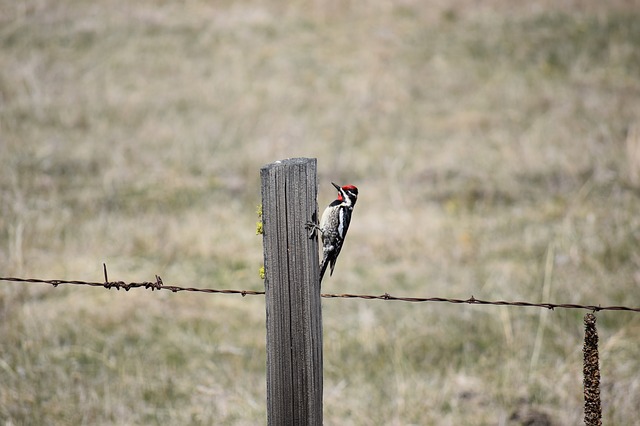
- Size: 19 – 21cm
- Weight: 32 – 66 grams
- Wingspan: 41 – 43cm
You’ll find red naped sapsuckers in the western region of Utah year round and in the remainder of the state when they happen to breed.
Red naped sapsucker are recognised by their black and white striped pattern on their back, face and wings, with red around their chin and mohawk feathers on the head. Females follow a similar color scheme minus the mohawk feathers and red elements.
These birds will often spend their time around mountains in mixed coniferous and deciduous forest, especially around aspens.
As for what red naped sapsuckers eat, it includes insects, tree sap, berries and other fruits.
Red naped sapsuckers are known to live for around 4 – 5 years in the wild.
5. Common Redpoll (Acanthis)
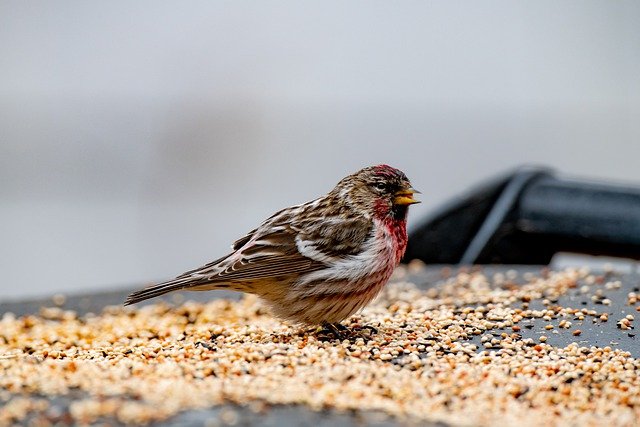
- Size: 12 – 14cm
- Weight: 11 – 20 grams
- Wingspan: 19 – 22cm
Common redpolls can be found all across the northern regions of Utah in their fall and winter non-breeding months.
These common redpolls are recognised by their red, white and brown plumage with their forehead and breast mixed with red and white, with the wings a combination of a brown and white color. Females also have a little spot on their forehead but, the remainder of their body is a brown and white color.
You’ll find a common redpoll located around boreal forests of pines, spruces and larches.
As for what these birds eat, it includes seeds from birch, alder and spruce along with a bunch of small insects like caterpillars, beetles, flies etc.
The longest lifespan that was recorded for a redpoll happened to be around 7 years and 10 months but, the majority of redpolls will live a good bit shorter, between the 4 – 5 year range.
6. Western Tanager (Piranga Ludoviciana)

- Size: 16 – 19cm
- Weight: 24 – 36 grams
- Wingspan: 27 – 31cm
You’ll be able to spot western tanagers breeding in the majority of Utah throughout spring and summer.
Western Tanagers are recognised by their red head, yellow body and their gray wings with yellowish/white stripes. The females are yellow too although it’s color is more dirty yellow with gray/black wings.
Western tanagers can be found within Open conifer or mixed forests.
Within these environments they will consume a variety of food sources like smaller fruits and berries like mulberries and elderberries as well as insects like wasps, bees, ants, beetles, grasshoppers, termites, cicada among other smaller insects.
Western tanagers tend to live upto 7 – 8 years in the wild.
7. Summer Tanager (Piranga Rubra)

- Size: 15 – 18cm
- Weight: 27 – 31 grams
- Wingspan: 28 – 30cm
Summer tanagers can be found in southwest Utah when breeding.
Male summer tanagers are recognised by their almost entirely red plumage with a grayish/silver beak. Females on the other hand are almost entirely yellow.
Summer tanagers are usually found within tropical forests of tall trees with an open canopy and mostly prefer to stay in lower elevations. They can reside within habitats that are 1800 meters above sea level too.
These tanagers mostly eat small insects like bees and wasps but, will also consume berries and smaller fruits foraged from backyards, parks among other environments rich with these food sources.
On average summer tanagers are known to live for around 5 years in the wild.
8. Northern Flicker (Colaptes Auratus)

- Size: 30 – 35cm
- Weight: 115 – 125 grams
- Wingspan: 50 – 55cm
These northern flickers can be found all across Utah on a year round basis.
Northern flickers are recognised by their mostly cream colored body with black spots, orange and black tail feathers and elements of red on the lower part of their face. Females look very similar to the males minus the red elements on their face.
You’ll often find northern flickers around woodlands, forest edges, and open fields with scattered trees, as well as city parks and suburbs.
As for what they tend to eat, it includes mostly insects along with smaller fruits and berries.
Northern flickers are known to live for around 5 – 7 years on average with the longest recorded to be 9 years and 2 months.
9. Red Winged Blackbird (Agelaius Phoeniceus)

- Size: 17 – 24cm
- Weight: 70 – 85 grams
- Wingspan: 31 – 40cm
Red winged blackbirds can be found in all of Utah on a year round basis.
Red winged blackbirds are mostly black but, like the red bellied woodpecker above they do have elements of red on them, which in this case is specifically on their wings.
Females are smaller and look very different from the males and don’t have the defining red patch on their wing. Instead their plumage is mostly a spotty gray/black and white pattern.
These blackbirds can be found in and around freshwater marshes, in wooded or brushy swamps, rank weedy fields, hayfields and the upper edges of salt marshes.
Red winged blackbirds tend to forage for their food, where they may do so around open fields and mudflats. As for what foods they eat, it consist mostly of seeds but smaller insects like flies, snails, bigger prey like lizards, crayfish and fruits are part of their diet too.
They tend to live for around 2 – 3 years in the wild although captive ones have been known to live in the 20 year range.
Amhil Khan, a dedicated nature enthusiast and the founder of BirdsOfTheWild.com, is a passionate advocate for the captivating world of avian wonders. With a deep-seated curiosity about the intricate lives of birds, Amhil’s journey began as a fascination and has evolved into a mission to inspire others to appreciate and protect these magnificent creatures.
Amhil’s love for birds led to the creation of Birds of the Wild, a platform where his expertise in ornithology, coupled with his captivating storytelling, provides readers with an immersive and educational experience. Through his lens and words, he captures the essence of birds in their natural habitats, offering a glimpse into their behaviors, migrations, and the ecosystems they inhabit.

